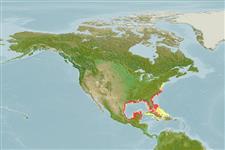>
Siluriformes (Catfishes) >
Ariidae (Sea catfishes) > Ariinae
Etymology: Ariopsis: Greek, ari = very, strength, superiority + Greek, opsis = appearance (Ref. 45335).
More on author: Linnaeus.
Environment: milieu / climate zone / profondeur / distribution range
Écologie
marin; saumâtre récifal. Subtropical; 43°N - 18°N, 98°W - 68°W
Western Atlantic: Massachusetts and northern Gulf of Mexico to southern Florida in USA and Mexico.
Length at first maturity / Taille / Poids / Âge
Maturité: Lm ?, range 13 - ? cm
Max length : 70.0 cm TL mâle / non sexé; (Ref. 40637); common length : 25.0 cm TL mâle / non sexé; (Ref. 3265); poids max. publié: 5.5 kg (Ref. 7251)
This species is distinguished from its congeners by the following characters: gill rakers on the first and second gill arches 29-32; osseous medial groove present; fleshy medial groove of neurocranium conspicuous and long, always surpassing the posterior margin of eyes; lateral margin of sphenotic notched, narrower medially than anteriorly; pterotic lateral margin smoothly convex; lateral margin of sphenotic notched, narrower medially than anteriorly; mouth 9.1-11.5% SL; close anterior nostrils 4.6-6.4% SL, close posterior nostrils 4.2-7.1% SL; mesethmoid median portion narrow, mesethmoid medial notch narrow and deep; gill rakers on the first gill arch 13–15, rarely 16; external posterior branch of lateral ethmoid columnar and thin; fenestra delimited by mesethmoid and lateral ethmoid conspicuous (Ref. 116660).
Cross section: oval.
Adults inhabit continental waters and enter estuaries. Found in turbid waters over muddy bottoms. Males incubate eggs in the mouth (Ref. 205). Commonly captured from catwalks, bridges and piers, particularly in passes and inland waterways. Edible, but generally not consumed (Ref. 7251).
Males carry the eggs in the mouth (Ref. 205).
Marceniuk, A.P., A.P. Acero, R. Cooke and R. Betancur-R, 2017. Taxonomic revision of the new world genus Ariopsis Gill (Siluriformes: Ariidae), with description of two new species. Zootaxa 4290(1):1-42. (Ref. 116660)
Statut dans la liste rouge de l'IUCN (Ref. 130435: Version 2025-1)
Menace pour l'homme
Traumatogenic (Ref. 58010)
Utilisations par l'homme
Pêcheries: intérêt commercial mineur; pêche sportive: oui
Outils
Articles particuliers
Télécharger en XML
Sources Internet
Estimates based on models
Preferred temperature (Réf.
123201): 23.3 - 27.8, mean 26.4 °C (based on 368 cells).
Phylogenetic diversity index (Réf.
82804): PD
50 = 0.5039 [Uniqueness, from 0.5 = low to 2.0 = high].
Bayesian length-weight: a=0.00631 (0.00513 - 0.00775), b=3.16 (3.10 - 3.22), in cm total length, based on LWR estimates for this species (Ref.
93245).
Niveau trophique (Réf.
69278): 3.2 ±0.0 se; based on diet studies.
Résilience (Réf.
120179): Faible, temps minimum de doublement de population : 4,5 à 14 années (Fec=55).
Fishing Vulnerability (Ref.
59153): Moderate to high vulnerability (48 of 100).
🛈
Nutrients (Ref.
124155): Calcium = 23.7 [8.3, 68.5] mg/100g; Iron = 0.501 [0.257, 0.899] mg/100g; Protein = 18.3 [16.5, 20.3] %; Omega3 = 0.13 [0.06, 0.26] g/100g; Selenium = 16.3 [7.1, 38.2] μg/100g; VitaminA = 37.1 [11.4, 129.3] μg/100g; Zinc = 0.927 [0.557, 1.534] mg/100g (wet weight);
